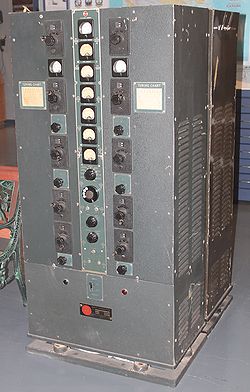C33 Transmitter
In Europe, it was used for communication from Army to Corps and Line of Communication units when mounted in a 3 Ton Canadian Military Pattern vehicle.
- No. 4 Technical Maintenance Section modified and installed almost all of the C 33 Sets about to be taken into use by the Canadian Army. At the instigation of Maj. P. D. Smith of First Canadian Army Signals they were equipped with pressel switch control, their receivers detached to be kept in other vehicles, their current consumption reduced with the use of new remote controls, and the sets mounted in new vehicles.[1]
Usage
These radios were used in August 1944 by elements of No. 4 Company of First Canadian Army Signals who were detached to organize a network between Headquarters First Canadian Army, Headquarters 9th U.S. Army and Headquarters 2nd Canadian Corps. Their tasks were several, but all of immediate importance. When it was proposed to bomb or shell a specific area of "The Gap", these sets were the means by which all were informed. More than once, troops changed position, informed higher commands, and by means of this liaison net it was possible to cancel quickly a barrage about to be laid down in the area to which the units had moved.[2]
Another interesting and novel use of the C33 sets was for providing a radio beacon to guide advancing tanks in darkness.[3]
- In Operation "Totalize" - the successful main assault down the Falaise road 7-10 August-an interesting experiment for Signals occurred again involving the control of tanks in the dark. The tanks of two armoured divisions and two armoured brigades advanced abreast through the flat wheat-fields that stretched for miles on either side of the highway. To keep them on course two main methods were adopted, both highly unusual. Tracer shells fired over the tanks by anti-aircraft Bofors guns showed the direction of advance and a novel directional beam was devised and operated by Signals to guide the tank drivers in the way an airplane pilot is brought in "on the beam". The equipment for this job was of highly makeshift order (using, among other things, electric windshield wiper motors borrowed from convenient jeeps) but it worked-a tribute to Signals' renowned ingenuity. Using No. 9 and No. 33 sets to transmit a directional beam, signals in the form of dots from one set and dashes from another were to be heard in the earphones of the tank crews. The driver kept his tank on course by manoeuvering so that dots and dashes were heard in his phones at equal volume. If the strength of the dots exceeded that of the dashes, he was too far to one flank. The success of the entire scheme depended primarily on how accurately Signals could maintain a distinction, and secondly upon the powers of discernment of the tank operator. Long hours were spent in preparing the experiment. In exhaustive trials by the 2nd Armoured Brigade it was found that as a sole means of direction, the beam was something less than satisfactory but that combined with the other methods it appeared to be a useful aid.
- This conclusion was borne out when the tanks went into action. Four armoured brigades, the 2nd Canadian, 4th Canadian, 1st Polish and 33rd British, were to use the beam. Transmission stations had to be set up in the line, with operators supplied by 2nd Canadian Corps Signals who supervised the siting and operation of these sets. Sets of the requisite power could not be manpacked, and accordingly 3-ton lorries, each drawing a 20-cwt. trailer, drove as far forward as possible. So rocky was the terrain that it was impossible to dig them in. For some hours before the attack they were subjected to continuous bombing and shelling, and the assault itself continued for ten hours. The experiment was a success. The majority of the tanks arrived on their targets despite ground mist, dust clouds and enemy smoke shells. Technical specialists in the Corps regretted that the idea of guiding tanks by wireless had not been promoted earlier, for given more time, there is no question but that they could have produced an entirely satisfactory system. As it was, they all had heavy responsibilities and lacked the time required to develop properly this enterprise.





